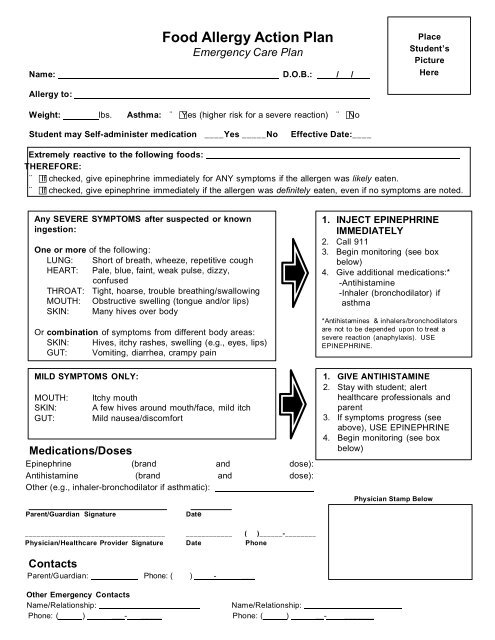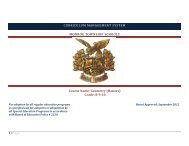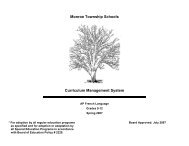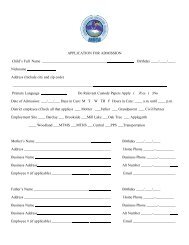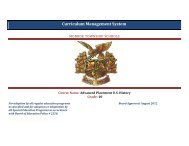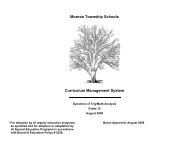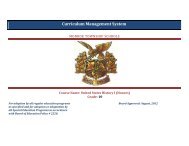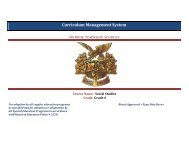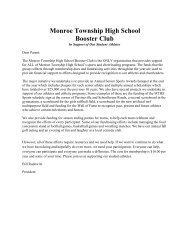Food Allergy Action Plan
Food Allergy Action Plan
Food Allergy Action Plan
You also want an ePaper? Increase the reach of your titles
YUMPU automatically turns print PDFs into web optimized ePapers that Google loves.
<strong>Food</strong> <strong>Allergy</strong> <strong>Action</strong> <strong>Plan</strong><br />
Emergency Care <strong>Plan</strong><br />
Name: D.O.B.: / /<br />
<strong>Allergy</strong> to:<br />
Weight: lbs. Asthma: ¨ Yes (higher risk for a severe reaction) ¨ No<br />
Student may Self-administer medication ____Yes _____No Effective Date:____<br />
Place<br />
Student’s<br />
Picture<br />
Here<br />
Extremely reactive to the following foods:<br />
THEREFORE:<br />
¨ If checked, give epinephrine immediately for ANY symptoms if the allergen was likely eaten.<br />
¨ If checked, give epinephrine immediately if the allergen was definitely eaten, even if no symptoms are noted.<br />
Any SEVERE SYMPTOMS after suspected or known<br />
ingestion:<br />
One or more of the following:<br />
LUNG: Short of breath, wheeze, repetitive cough<br />
HEART: Pale, blue, faint, weak pulse, dizzy,<br />
confused<br />
THROAT: Tight, hoarse, trouble breathing/swallowing<br />
MOUTH: Obstructive swelling (tongue and/or lips)<br />
SKIN: Many hives over body<br />
Or combination of symptoms from different body areas:<br />
SKIN: Hives, itchy rashes, swelling (e.g., eyes, lips)<br />
GUT: Vomiting, diarrhea, crampy pain<br />
MILD SYMPTOMS ONLY:<br />
MOUTH: Itchy mouth<br />
SKIN: A few hives around mouth/face, mild itch<br />
GUT: Mild nausea/discomfort<br />
Medications/Doses<br />
Epinephrine (brand and dose):<br />
Antihistamine (brand and dose):<br />
Other (e.g., inhaler-bronchodilator if asthmatic):<br />
Parent/Guardian Signature Date<br />
____________________________________ ____________ ( )______-________<br />
Physician/Healthcare Provider Signature Date Phone<br />
Contacts<br />
Parent/Guardian: Phone: ( ) - ___<br />
1. INJECT EPINEPHRINE<br />
IMMEDIATELY<br />
2. Call 911<br />
3. Begin monitoring (see box<br />
below)<br />
4. Give additional medications:*<br />
-Antihistamine<br />
-Inhaler (bronchodilator) if<br />
asthma<br />
*Antihistamines & inhalers/bronchodilators<br />
are not to be depended upon to treat a<br />
severe reaction (anaphylaxis). USE<br />
EPINEPHRINE.<br />
1. GIVE ANTIHISTAMINE<br />
2. Stay with student; alert<br />
healthcare professionals and<br />
parent<br />
3. If symptoms progress (see<br />
above), USE EPINEPHRINE<br />
4. Begin monitoring (see box<br />
below)<br />
Physician Stamp Below<br />
Other Emergency Contacts<br />
Name/Relationship: _______________________ Name/Relationship: ___________________<br />
Phone: ( ) ___- _____ Phone: ( ) __- _______
EpiPen ® (epinephrine) Auto-Injector Directions<br />
• First, remove the EpiPen ® (epinephrine)<br />
Auto-Injector from the plastic carrying case<br />
• Pull off the blue safety release cap<br />
• Hold orange tip near outer thigh (always<br />
apply to thigh)<br />
• Swing and firmly push orange tip against<br />
outer thigh. Hold on thigh for approximately<br />
10 seconds.<br />
Remove EpiPen ® (epinephrine) Auto-Injector and<br />
massage the area for 10 more seconds.<br />
EpiPen ® , EpiPen 2-Pak ® , and EpiPen Jr 2-Pak ® are registered trademarks of Mylan Inc. licensed exclusively to<br />
its wholly-owned subsidiary, Mylan Specialty L.P.<br />
Auvi-Q TM (epinephrine injection, USP) Directions<br />
Remove the outer case of Auvi-Q. This will<br />
automatically activate the voice instructions.<br />
Pull off RED safety guard.<br />
© 2002-2013 sanofi-aventis U.S. LLC. All rights reserved.<br />
Place black end<br />
against outer thigh,<br />
then press firmly and<br />
hold for 5 seconds.<br />
Adrenaclick ® 0.3 mg and<br />
Adrenaclick ® 0.15 mg Directions<br />
Remove GREY caps labeled<br />
“1” and “2.”<br />
Place RED rounded tip against<br />
outer thigh, press down hard until needle<br />
penetrates. Hold for 10 seconds, then remove.<br />
A food allergy response kit should contain at least two doses of epinephrine, other medications as<br />
noted by the student’s physician, and a copy of this <strong>Food</strong> <strong>Allergy</strong> <strong>Action</strong> <strong>Plan</strong>.<br />
A kit must accompany the student if he/she is off school grounds (i.e., field trip).<br />
Monitoring<br />
Stay with student; alert healthcare professionals and parent. Tell rescue squad epinephrine was given;<br />
request an ambulance with epinephrine. Note time when epinephrine was administered. A second dose of<br />
epinephrine can be given 5 minutes or more after the first if symptoms persist or recur. For a severe<br />
reaction, consider keeping student lying on back with legs raised. Treat student even if parents cannot be<br />
reached. See above for auto-injection technique.<br />
Form provided courtesy of the <strong>Food</strong> <strong>Allergy</strong> Research & Education (FARE) (www.foodallergy.org) 4/2013


